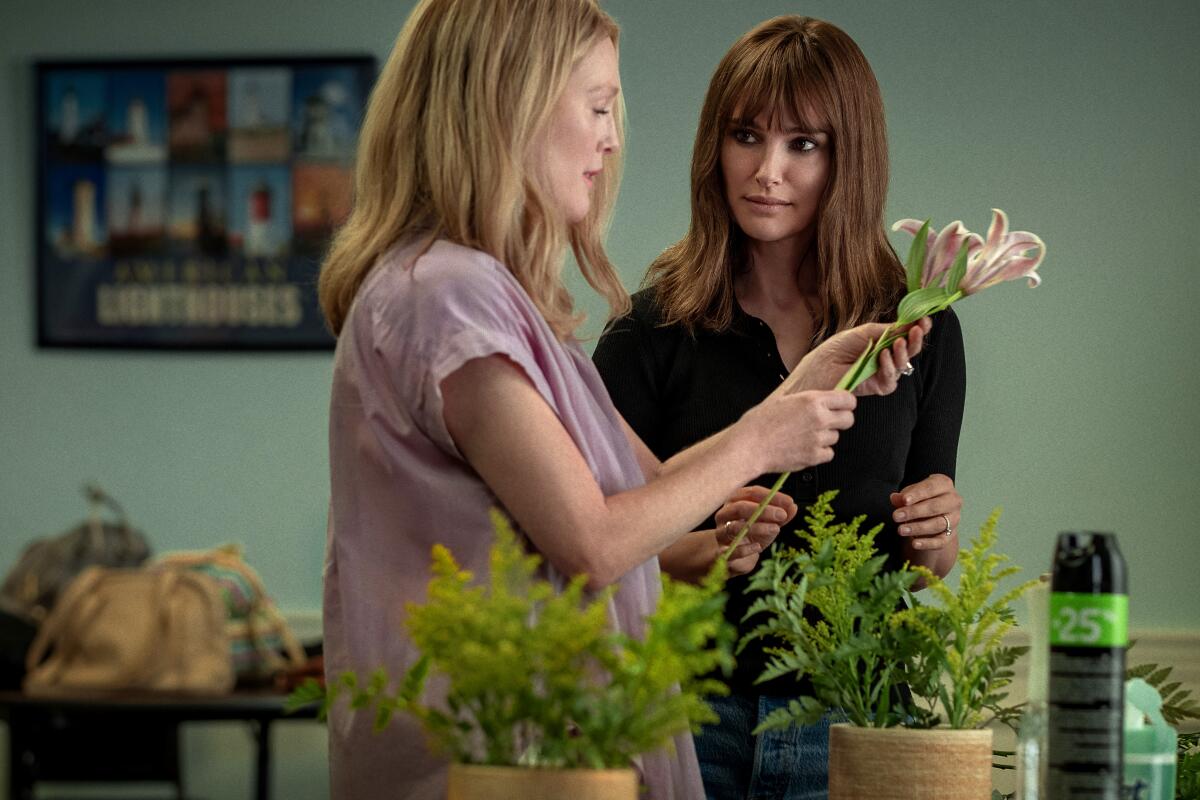Sign up for The Envelope
Get exclusive awards season news, in-depth interviews and columnist Glenn Whipp’s must-read analysis straight to your inbox.
You may occasionally receive promotional content from the Los Angeles Times.

Although it’s not based on a true story, a common cultural memory threads through Todd Haynes’ “May December.” Writer Samy Burch was inspired by Mary Kay Letourneau, a teacher who was caught having sexual relations with a 12-year-old student and ended up marrying him. In the film, an actor named Elizabeth Berry (Natalie Portman) arrives in Savannah, Ga., to observe a woman, Gracie Atherton-Yoo (Julianne Moore), with a very similar story to Letourneau’s.
“What was so brilliant about Samy’s script is the whole thing is 20-plus years after the fact, so that’s all in the past,” Haynes says, speaking in London. “What you really are seeing is how people survived something like that and where they are now and the fortress that’s been built around them to protect them from what they went through. She’s been arrested, she went to prison, they married, they raised three kids, they tried to live as normal lives as they could — and then here comes this outsider who’s going to start chipping away at all of that. That allowed so much of an interesting distance from the original tabloid story.”
The script for “May December,” now streaming on Netflix, came to Haynes via Portman, whom the director had tried to collaborate with once before, in the midst of the pandemic. Haynes, who says he gets sent a lot of screenplays, was immediately drawn to the confidence of the storytelling.
Natalie Portman, Julianne Moore and Charles Melton enact a mesmerizing psychological triangle in the latest self-deconstructing melodrama from Todd Haynes (“Carol”).
“It held back from casting judgment on these characters and allowed that uncertainty in the reader to be enticed and intoxicated and inflected with humor,” he recalls. “The tone of it was so interesting. There was nothing like it. Natalie and I started to talk about the character of Elizabeth right away. She was really stimulated by the idea that the viewer might project assumptions about her, the actor Natalie Portman, onto the character. That excited her as opposed to worrying her. And then, of course, I called Julianne.”
Aligning everyone’s schedule was challenging, so the team put the film on hold for a while. Then, last year, another movie Haynes was developing fell through, and a small window of time opened in the fall. Everyone jumped on it. Haynes tweaked the script’s setting of Camden, Maine, to Savannah, and he and production designer Sam Lisenco found a house on Tybee Island that seemed right for Gracie and her young husband, Joe (Charles Melton). The location ended up being pivotal to the film’s aesthetic.
“The haziness of the light and filtration came specifically from deciding to shoot it in Savannah,” Haynes says. “The quality of light is so specific, and the precipitation lodged in the sliding glass doors that smeared the visibility through the window, that became our inspiration for how to filter the lenses throughout the film.”

Production lasted only 23 days, but the short timeline generated a sense of energy and adrenaline. Haynes says everyone felt part of the same “lifeblood moment.” It resulted in a deeply pleasurable filmmaking experience, which the director doesn’t always have on his sets. It also meant that he didn’t spend too much time lingering on certain scenes or shots. The final encounter between Elizabeth and Gracie, for example, used the first and only take. Every detail was planned in advance, from wigs to costumes, so that once the actors got in front of the camera they could become fully immersed. Many scenes were filmed in a single, unmoving shot, often with the actors looking into a mirror. Haynes was inspired by Ingmar Bergman’s work, specifically his 1966 film “Persona.”
“I knew that mirrors played a motif in the film,” Haynes says. “I knew that I wanted to shoot the final monologue with Natalie Portman looking into the lens of the camera, and I thought, ‘OK, if that’s where we end, how do we get there?’ I thought [mirrors] would expose and activate this idea of looking and who’s looking at who and who is not looking and who is disinclined to look at themselves and why. It was a concise and active way to implicate that in a shot. But those kinds of ideas are all well and good. What you need is the most extraordinary actors, because you’re holding shots for sometimes seven or eight minutes long without a cut.”
The director of “Carol” discusses his latest film, its connection to the Mary Kay Letourneau scandal, working with Julianne Moore and his career to date.
Although “May December” doesn’t judge its characters, it is unflinching in its portrayal of a woman who had a relationship with a 12-year-old boy and has since refused to acknowledge the cracks it generated around her. Elizabeth’s presence, which becomes more and more unreliable, exposes a rift between Gracie and Joe, who at age 36 is sending his youngest children off to college. For Haynes, an examination of this one relationship was an opportunity for the ideas to resonate more broadly.
“The ways people survive things is about the way we’re not inclined to look at ourselves or question our choices in life,” Haynes says. “And that’s all fine — you want to commit to the relationships you’ve chosen for yourself and the families that you’re in. Until you realize you’re not happy in them and then you realize we don’t often have the tools to think differently about what we’ve done.”

“May December” evokes a very specific tone, wavering between witty humor and emotional drama, which Haynes says was inherent in the script. It’s often uncomfortable, in a compelling way. The score, by Marcelo Zarvos, adapts Michel Legrand’s from “The Go-Between,” and Haynes often played the original music on set while filming to add to the mood. Although the film isn’t necessarily similar to Haynes’ more recent work, it hits on something he admires in other filmmakers, namely Alfred Hitchcock: conjoining the subversive with the popular.
“I’m attracted to that,” he says, “even if my subversive elements draw maybe more from other, sometimes less popular genres than his employ. I’ve always been interested in the history of narrative and film and draw from that as a language that we all know and can find our way through. And then I want to stir up something where the viewer of the movie comes with knowledge and expectations that they bring to the movie and those expectations are skirted or undermined or twisted. And they have to go, ‘Hmm, that’s different.’”
Sign up for The Envelope
Get exclusive awards season news, in-depth interviews and columnist Glenn Whipp’s must-read analysis straight to your inbox.
You may occasionally receive promotional content from the Los Angeles Times.